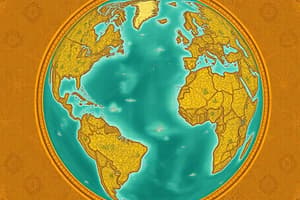Podcast
Questions and Answers
Earth is an oblate spheroid, which means it is mostly spherical but has a slight flattening at the poles.
Earth is an oblate spheroid, which means it is mostly spherical but has a slight flattening at the poles.
True (A)
The average radius of Earth is approximately 12,742 kilometers.
The average radius of Earth is approximately 12,742 kilometers.
False (B)
About 29.2% of Earth's surface is covered by water.
About 29.2% of Earth's surface is covered by water.
False (B)
Earth's total surface area is approximately 510.1 million square kilometers.
Earth's total surface area is approximately 510.1 million square kilometers.
Earth's surface area is larger than that of Jupiter.
Earth's surface area is larger than that of Jupiter.
Earth is a perfect sphere without any flattening at the poles.
Earth is a perfect sphere without any flattening at the poles.
The spherical shape of Earth impacts sunlight distribution and affects climate zones.
The spherical shape of Earth impacts sunlight distribution and affects climate zones.
Gas giants like Jupiter and Saturn have smaller equatorial bulges due to their rapid rotation.
Gas giants like Jupiter and Saturn have smaller equatorial bulges due to their rapid rotation.
Mercury is nearly spherical, being only slightly more flattened than Earth.
Mercury is nearly spherical, being only slightly more flattened than Earth.
Earth's shape contributes to the circulation of the atmosphere and oceans.
Earth's shape contributes to the circulation of the atmosphere and oceans.
Flashcards are hidden until you start studying
Study Notes
Earth Planet Shape and Size: Surface Area
-
Shape of Earth:
- Earth is an oblate spheroid, meaning it is mostly spherical but slightly flattened at the poles and bulging at the equator.
-
Surface Area Calculation:
- The formula for the surface area (A) of a sphere:
( A = 4\pi r^2 )
where ( r ) is the radius of the sphere.
- The formula for the surface area (A) of a sphere:
-
Average Radius of Earth:
- The average radius of Earth is approximately 6,371 kilometers (3,959 miles).
-
Total Surface Area of Earth:
- Using the average radius:
( A \approx 4\pi (6,371)^2 )
which results in an approximate total surface area of 510.1 million square kilometers (197.3 million square miles).
- Using the average radius:
-
Distribution of Surface Area:
- Land: About 29.2% of Earth's surface is land.
- Water: Approximately 70.8% is covered by water, primarily oceans.
-
Impact of Topography:
- Earth's surface features (mountains, valleys, plains, etc.) affect local surface area calculations but do not change the overall total surface area significantly.
-
Comparison with Other Celestial Bodies:
- Earth's surface area is larger than that of the Moon and smaller than that of some gas giants like Jupiter and Saturn.
-
Importance of Surface Area:
- Surface area influences climate, weather patterns, and ecosystem dynamics.
- It also plays a role in human activities, such as agriculture, urban development, and resource management.
Shape of Earth
- Earth is classified as an oblate spheroid, indicating a nearly spherical shape that is slightly flattened at the poles and bulging at the equator.
Surface Area Calculation
- Surface area (A) of a sphere is determined using the formula ( A = 4\pi r^2 ), where ( r ) represents the radius.
Average Radius of Earth
- The average radius of Earth measures approximately 6,371 kilometers (or 3,959 miles).
Total Surface Area of Earth
- By applying the average radius in the surface area formula, Earth’s total surface area calculates to roughly 510.1 million square kilometers (197.3 million square miles).
Distribution of Surface Area
- Land comprises about 29.2% of the Earth's surface, while water covers approximately 70.8%, predominantly in the form of oceans.
Impact of Topography
- Local surface area calculations can be influenced by Earth's diverse topography, such as mountains and valleys, though this does not substantially alter the overall surface area.
Comparison with Other Celestial Bodies
- Earth’s surface area exceeds that of the Moon but is less than that of gas giants like Jupiter and Saturn.
Importance of Surface Area
- Surface area plays a crucial role in climatic conditions, weather patterns, and ecosystem interactions.
- It is also significant for human endeavors including agriculture, urbanization, and resource management.
Earth's Spherical Shape
- Earth is classified as an oblate spheroid, indicating it is slightly flattened at the poles and bulges at the equator.
- The force of gravity contributes to the spherical shape by pulling matter toward the center.
- The equatorial diameter of Earth is approximately 43 kilometers larger compared to the polar diameter.
Importance Of Earth's Shape
- The shape of Earth influences climate and weather patterns, as it affects how sunlight is distributed across different regions.
- Navigation and mapping are impacted by Earth’s curvature, facilitating more accurate models for mapping and satellite positioning.
- The spherical form of Earth affects atmospheric dynamics, playing a crucial role in the circulation of both the atmosphere and ocean currents, which in turn shapes global climates and ecosystems.
Comparison To Other Planets
- Many planets in the solar system share the oblate spheroid shape, a result of their rotation, including giant planets like Jupiter and Saturn.
- Mercury is nearly spherical but is slightly more flattened than Earth.
- Mars exhibits a less pronounced equatorial bulge, with surface features that differ significantly due to the absence of liquid water.
- Gas giants like Jupiter and Saturn exhibit larger equatorial bulges because of their rapid rotation and gaseous composition.
- Smaller celestial bodies, such as some moons and dwarf planets like Pluto, often have irregular shapes due to their lower mass and insufficient gravity to achieve a spherical form.
Studying That Suits You
Use AI to generate personalized quizzes and flashcards to suit your learning preferences.




